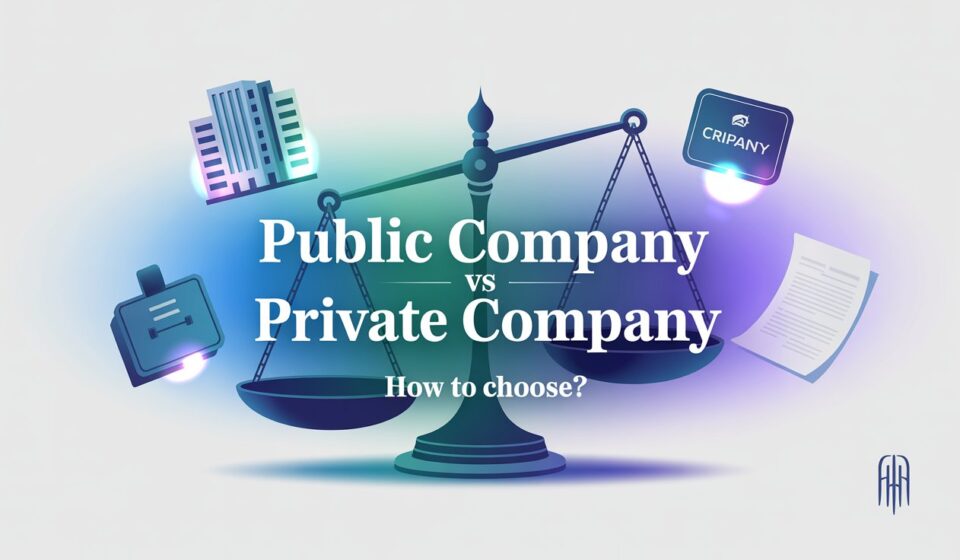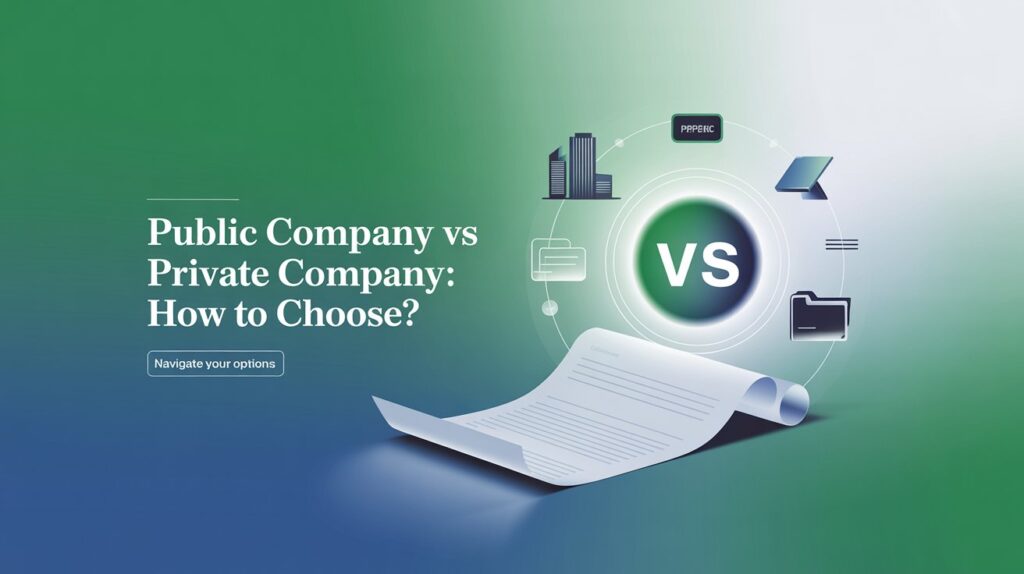
Public Company vs Private Company : Key Differences, Pros & Cons, and How to Choose
Public vs private company explained: legal differences in India, pros & cons, funding & conversion process, practical checklist for founders and investors.
Table Of Content
- Introduction
- What is a Private Company?
- What is a Public Company?
- Major legal & regulatory points
- Side-by-side comparison
- Funding, liquidity & exit options
- Governance & compliance: what changes after listing?
- Tax & financial implications
- How to convert: Private to Public (Overview)
- Real-world mini case studies
- Practical checklist – Which one is right for you?
- FAQs ( Question? Answers )
- Can a private company go public?
- What are the disclosure requirements for public companies?
- How many shareholders can a private company have?
- How does taxation differ for public vs private?
- Can promoters retain control after an IPO?
Introduction
You’re an early-stage founder. Your SaaS product is growing fast, VCs are calling, and a larger rival hints at acquiring you or you could list in three years and give your team a real exit. The question that keeps circling is simple but huge: stay private or go public? Understanding public company vs private company isn’t academic it shapes control, funding, compliance, and your exit options. Let’s walk through what each structure means in India and how to decide.
What is a Private Company?
A private company (often “Pvt Ltd”) is a company that restricts share transferability, limits members (typically up to 200), and does not invite the public to subscribe to shares. It’s commonly used by startups and small to mid businesses for close control and flexibility. Key features are limited liability, restricted share transfers, and fewer mandatory public disclosures. (Companies Act, 2013: Section 2(68)).
What is a Public Company?
A public company may offer shares to the public and, if listed, trades on stock exchanges. It has no upper limit on the number of shareholders and must comply with stricter governance and disclosure norms under the Companies Act, 2013 and SEBI Listing Obligations and Disclosure Requirements (LODR) for listed entities. Public companies are designed for large-scale capital raising and broad investor participation.
Major legal & regulatory points
- Companies Act, 2013: Defines private/public companies, shareholder limits, director requirements and filing obligations. Laws and sections referenced here are current as of Aug 2025.
- SEBI LODR Regulations (Listing Obligations and Disclosure Requirements): Governs disclosure, continuous reporting, insider trading norms and corporate governance for listed companies; last amended May 1, 2025.
- Registrar of Companies (RoC): All companies (private & public) file annual returns and financials with the RoC (MCA portal).
Legal note:
This article summarises legal distinctions as of August 2025. For binding legal advice, consult a corporate lawyer and primary sources (MCA, SEBI).

Side-by-side comparison
| Feature | Private Company | Public Company |
|---|---|---|
| Ownership & shareholders | Closely held; often founders, angels, PE. | Broad public ownership; retail & institutional investors. |
| Min/Max shareholders | Min 2; Max 200 (excl. employees). | Min 7; No upper limit. |
| Share transferability | Restricted (Articles often require consent). | Freely transferable if listed; subject to law for unlisted public co. |
| Raise capital publicly? | No. Cannot invite public to subscribe. | Yes. Can raise via IPO, FPO, rights issue. |
| Disclosure & filing | ROC filings, annual return; less frequent public disclosure. | Rigorous continuous disclosures (LODR), quarterly results, prospectus rules. (Securities and Exchange Board of India) |
| Board & governance | Fewer formalities; smaller board typical. | Larger board; independent directors; stricter committees (audit, nomination). |
| Statutory audits | Annual audit mandatory; frequency like public. | Annual audit + stricter internal controls; audit committees mandatory. |
| Regulatory oversight | RoC, MCA, Ministry of Corporate Affairs. | RoC + SEBI (if listed) + stock exchanges (NSE/BSE). |
| Typical use-cases | Startups, family businesses, small-medium enterprises. | Large companies seeking broad capital and liquidity. |
| Time & cost to set up | Faster & cheaper to incorporate and operate. | Higher cost (prospectus, merchant bankers, compliance) and longer timeframe. |
Funding, liquidity & exit options
- Private company: Funding comes from angel investors, VCs, PE or strategic buyers. Liquidity events are typically secondary sales, M&A, or eventual IPO. Example: Flipkart remained private through multiple funding rounds and later sold a majority stake to Walmart – avoiding a public listing until strategic timing (Walmart deal 2018).
- Public company: Access to public equity and deeper pools of capital. IPOs provide liquidity for founders and employees but require public disclosure and market scrutiny. Example: Zomato listed via IPO in 2021 and gained immediate public liquidity and valuation discovery.
Governance & compliance: what changes after listing?
Listed public companies must implement:
- Independent directors, audit and nomination committees.
- Quarterly financial reporting and immediate disclosure of material events (price-sensitive information).
- Insider trading policies, related-party transaction approvals and enhanced shareholder protections. See SEBI LODR.
Private companies enjoy operational flexibility and confidentiality (useful for strategy, M&A talks, or R&D), but they must still comply with Companies Act filings, tax audits (if threshold crossed), and other statutory obligations.
Tax & financial implications
Taxation depends on corporate structure and profit:
- Corporate tax rates are broadly similar for private and public limited companies (subject to incentives and special rates).
- Listing can affect valuation, employee stock option liquidity, and the way investor returns are structured (dividends vs capital gains). Seek a tax advisor for transaction-level planning.
How to convert: Private to Public (Overview)
- Board & shareholder approvals (special resolutions).
- Comply with Companies Act eligibility (paid-up capital, creditors’ consent).
- Due diligence & prospectus drafting (merchant banker appointment).
- File DRHP/IPO papers with SEBI (Draft Red Herring Prospectus).
- Compliance with SEBI comments -> IPO pricing -> Listing.
Typical time: 6–12 months (can be longer). Costs include merchant banker fees, legal, accounting, underwriting and listing fees. SEBI and stock exchanges supervise the process.
Real-world mini case studies
Case A : Stayed private & scaled: Flipkart raised multiple private rounds, partnered with strategic investors, and sold a controlling stake to Walmart (2018). Staying private let it grow aggressively without quarterly market pressure; the Walmart deal provided liquidity and global scale.
Case B : Went public and gained liquidity: Zomato listed on stock exchanges in July 2021. IPO provided capital for expansion and immediate liquidity to investors and employees, but also meant public scrutiny over margins and frequent stock volatility.
Practical checklist – Which one is right for you?
Ask yourself:
- Funding needs: Do you need large public capital now? -> Public favours big raises.
- Control preference: Do you want to retain tight control? -> Private helps preserve promoter control.
- Compliance appetite: Can you handle ongoing public disclosures & governance? -> If no, stay private.
- Timeline to exit: Need fast liquidity for employees/investors? -> Public may be better.
- Valuation & growth: Are you ready for market valuation scrutiny? -> If comfortable, consider going public.
Quick scorecard: If you answered “yes” to 3+ items under funding & liquidity -> consider planning for public listing.
FAQs ( Question? Answers )
Can a private company go public?
Yes – via an IPO after meeting Companies Act and SEBI requirements; process takes several months.
What are the disclosure requirements for public companies?
Listed firms must comply with SEBI LODR: quarterly results, annual reports, immediate disclosure of material events.
How many shareholders can a private company have?
A private company is generally limited to 200 members (excl. employee shareholders).
How does taxation differ for public vs private?
Tax rates are generally the same; differences arise in capital gains, dividend tax considerations and transaction tax planning. Consult a tax advisor.
Can promoters retain control after an IPO?
Yes – through shareholding retention and mechanisms like promoter-pledging, but public company governance and minority protections limit absolute control.
Highlighted insight:
“Choosing public or private isn’t just about capital – it’s about culture, control, and the kind of scrutiny you and your team are ready for.”



